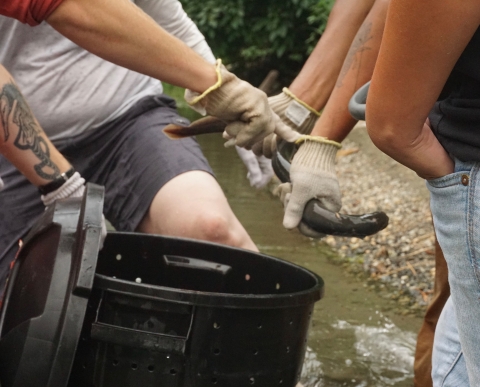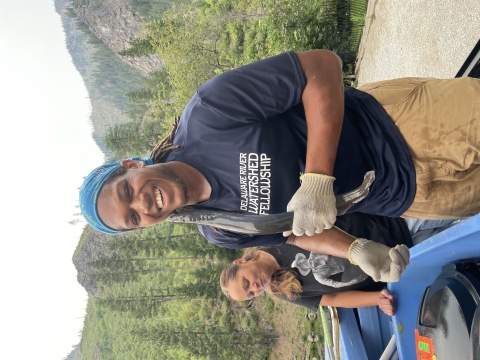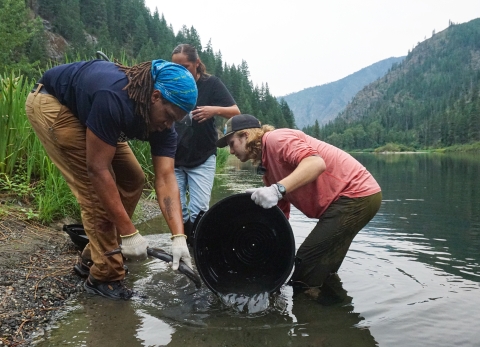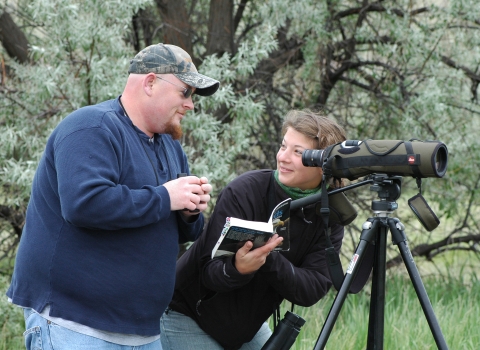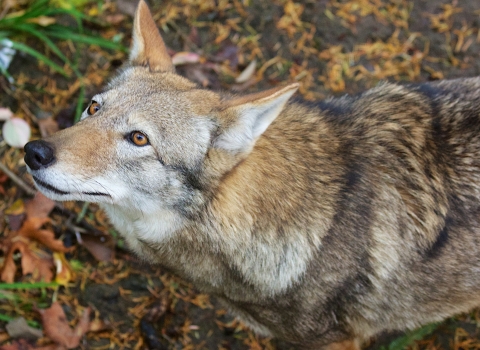On an overcast afternoon, I find myself hauling bins to the banks of the Wenatchee River with fellow biologists. I struggle to grip the handles as something alive and energetic thrashes inside. I peer curiously over the rim, and my gaze is met with a writhing mass of Pacific lamprey.
Pacific lamprey are some of the oldest fish alive today and were once abundant in the upper Wenatchee River. Today, these ancient fish are far less common. The Yakama Nation Fisheries, in partnership with the U.S. Fish and Wildlife Service (Service), is using generations of traditional knowledge and modern science to tackle this potential conservation catastrophe.
Pacific lamprey travel between river systems and the ocean, traversing miles of river and multiple dams in order to spawn in the Columbia River Basin.
Many Tribes have deep cultural ties to the Pacific lamprey and have been harvesting the species as a food source for millennia. Because of this, Tribal fisheries were among the first organizations to address the Pacific lamprey population decline in the upper Wenatchee.
In addition to their cultural significance, Pacific lamprey perform many ecosystem services, but lamprey conservation is still often overlooked. Ann Grote, a Service biologist, attributes this lack of attention to a lack of perceived economic value. “Salmon, to the dominant culture, have more perceived value. People are sport fishing for salmon… people are eating salmon, so in the bigger economy they are more valuable,” she explains.
In 2004, Pacific lamprey were considered for protection under the Endangered Species Act, but they did not qualify. Without this protected status, Native American Tribes including the Umatilla, Nez Perce, Yakama and many others were best equipped to spearhead these conservation efforts, often partnering with government agencies for assistance. The Yakama Nation Fisheries stepped into this role skillfully, partnering with the Service to relocate spawning lamprey above dams to the upper Wenatchee River.
In addition to the efforts on the Wenatchee River, the Pacific Lamprey Conservation Initiative (PLCI) is working to conserve Pacific Lamprey throughout its range in California, Oregon, Washington, Idaho, and Alaska. PLCI is a collaboration of Native American Tribes, federal, state, municipal and local agencies with a goal of achieving long-term persistence of Pacific lamprey and their habitats, and support traditional Tribal cultural use of Pacific lamprey throughout their historic range. It is a great example of collaborative conservation being done outside of the Endangered Species Act protections, and was launched at the urging of the Columbia River Tribes after the petition to list was found to be unwarranted.
Today, we stand waist deep in the Wenatchee River, carrying out the conservation vision that began years before. Since this project’s inception, Pacific lamprey have been detected at many of the release sites, indicating their distribution is expanding.
This lamprey restoration effort is one of many taking place across the Pacific Northwest.
A multitude of these projects involve partnerships between Tribes and government agencies. The combination of knowledge and resources that these partnerships provide results in effective and equitable solutions to conservation problems.
If it wasn’t for the environmental stewardship of Tribes, the landscapes we love would look vastly different. This is something I contemplate as I release the prehistoric fish we have brought to the river. I look down at the lamprey in my hands, acknowledging the millennia of evolutionary and cultural history it represents. I then let it go, watching it slip away into the water: an old friend returning home.
Article by Sarah Ortiz, a Student Conservation Association intern with the Mid-Columbia Fish and Wildlife Conservation Office.


